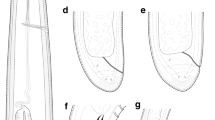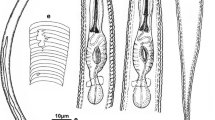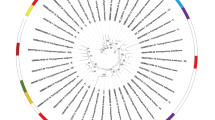Abstract
Some nematode species in the Longidoridae are important agricultural pests because they are vectors of nepoviruses. Species in the Xiphinema americanum group have been widely studied because they transmit at least four nepoviruses. The identity, taxonomy and worldwide distribution of nematodes in the group remain much debated. At least three species in this group have been described from New Zealand, but DNA techniques were not used in these studies. These techniques are highly discriminatory for identifying closely related species. We are in the process of barcoding New Zealand nematodes for biosecurity and pest management purposes. Here we describe the identification of X. brevicollum, a nematode from the X. americanum group, using DNA sequencing of the ribosomal large subunit D2/D3 and internal transcribed spacer-1 regions, from New Zealand. Additional keywords: cloning, ZyGEM DNA extraction.
Similar content being viewed by others
References
Altschul SF, Madden TL, Schäffer AA, Zhang J, Zhang Z, Miller W (1997) Gapped BLAST and PSI-BLAST: a new generation of protein database search programs. Nucleic Acids Research 25, 3389–3402. doi: 10.1093/ nar/25.17.3389
Baldwin JG, Frisse LM, Vida JT, Eddleman CD, Thomas WK (1997) An evolutionary framework for the study of developmental evolution in a set of nematodes related to Caenorhabditis elegans. Molecular Phylogenetics and Evolution 8, 249–259. doi: 10.1006/mpev.1997.0433
Bell NL, Davis LT, Sarathchandra SU, Barratt BIP, Ferguson CM, Townsend RJ (2005) Biodiversity of indigenous tussock grassland sites in Otago, Canterbury and the central North Island of New Zealand. II. Nematodes. Journal of the Royal Society of New Zealand 35, 303–319.
Boutsika K, Phillips MS, MacFarlane SA, Brown DJF, Holeva RC, Blok VC (2004) Molecular diagnostics of some trichodorid nematodes and associated Tobacco rattle virus. Plant Pathology 53, 110–116. doi: 10.1046/j.1365-3059.2003.00938.x
Brown DJF, Halbrendt JM, Jones AT, Vrain TC, Robbins RT (1994) Transmission of three North American nepoviruses by populations of four distinct species of the Xiphinema americanum group. Phytopathology 84, 646–649. doi: 10.1094/Phyto-84-646
Brown DJF, Robertson WM, Trudgill DL (1995) Transmission of viruses by plant nematodes. Annual Review of Phytopathology 33, 223–249. doi: 10.1146/annurev.py.33.090195.001255
Bulman SR, Marshall JW (1998) Detection of Spongospora subterranea in potato tuber lesions using the polymerase chain reaction (PCR). Plant Pathology 47, 759–766.
Bulman SR,Stufkens MAW, Eastop VF, Teulon DAJ (2005) Rhopalosiphum aphids in New Zealand. II. DNA sequences reveal two incompletely described species. New Zealand Journal of Zoology 32, 37–45.
Chen DY, Ni HF, Yen JH, Cheng YH, Tsay TT (2005) Differentiation of the Xiphinema americanum-group nematodes X. brevicollum, X. incognitum, X. diffusum and X. oxycaudatum in Taiwan by morphometrics and nuclear ribosomal DNA sequences. Nematology 7, 713–725. doi: 10.1163/156854105775142937
Felsenstein J (1985) Confidence limits on phylogenies: an approach using the bootstrap. Evolution 39, 783–791. doi: 10.2307/2408678
Ferrari BC, Power ML, Bergquist PL (2007) Closed-tube DNA extraction using a thermostable proteinase is highly sensitive, capable of single parasite detection. Biotechnology Letters 29, 1831–1837. doi: 10.1007/ s10529-007-9487-2
Floyd R, Abebe E, Papert A, Blaxter M (2002) Molecular barcodes for soil nematode identification. Molecular Ecology 11, 839–850. doi: 10.1046/ j.1365-294X.2002.01485.x
He Y, Subbotin SA, Rubtsova TV, Lamberti F, Brown DJF, Moens M (2005) A molecular phylogenetic approach to Longidoridae (Nematoda: Dorylaimida). Nematology 7, 111–124. doi: 10.1163/1568541054 192108
Holterman M, Rybarczyk K, Van den Elsen S, Van Megen H, Mooyman P, Santiago RP, Bongers T, Bakker J, Helder J (2008) A ribosomal DNA-based framework for the detection and quantification of stresssensitive nematode families in terrestrial habitats. Molecular Ecology Resources 8, 23–34. doi: 10.1111/j.1471-8286.2007.01963.x
Hunt DL (1993) ‘Aphelenchida, Longidoridae and Trichodoridae: their systematics and bionomics.’ (CAB International: Wallingford, UK)
Kimura M (1980) A simple model for estimating evolutionary rates of base substitutions through comparative studies of nucleotide sequences. Journal of Molecular Evolution 16, 111–120. doi: 10.1007/BF01731581
Kumari S, Polak J, Choutka R (2005) Plant-parasitic nematodes of the genus Xiphinema (Nematoda: Longidoridae) in the vineyards of the Czech Republic. Nematology 7, 81–93. doi: 10.1163/1568541054192117
Lamberti F, Ciancio A, Agostinelli A, Coiro MI (1991) Relationship between Xiphinema brevicollum and X. diffusum, with a redescription of Xiphinema brevicollum and description of three new species of Xiphinema (Nematoda: Dorylaimida). Nematologia Mediterranea 19, 311–326.
Lamberti F, Molinari S, Moens M, Brown DJF (2000) The Xiphinema americanum group. I. Putative species, their geographical occurrence and distribution, and regional polytomous identification keys for the group. Russian Journal of Nematology 8, 65–84.
Loof PAA, Coomans A, Baujard P, Luc M (2001) On five species of the genus Xiphinema Cobb, 1913 (Nematoda: Longidoridae) recently described from India. Nematology 3, 277–283. doi: 10.1163/ 156854101750413351
Lordello LGE, Da Costa CP (1961) A new nematode parasite of coffee roots in Brazil. Revista Brasileira de Biologia 21, 363–366.
Luc M, Coomans A, Loof PAA, Baujard P (1998) The Xiphinema americanum group (Nematoda: Longidoridae). 2. Observations on Xiphinema brevicollum Lordello & da Costa, 1961 and comments on the group. Fundamental and Applied Nematology 21, 475–490.
Oliveira CMG, Fenton B, Malloch G, Brown DJF, Neilson R (2005) Development of species-specific primers for the ectoparasitic nematode species Xiphinema brevicolle, X. diffusum, X. elongatum, X. ifacolum and X. longicaudatum (Nematoda: Longidoridae) based on ribosomal DNA sequences. The Annals of Applied Biology 146, 281–288. doi: 10.1111/j.1744-7348.2005.040031.x
Saitou N, Nei M (1987) The neighbour-joining method: a new method for reconstructing phylogenetic trees. Molecular Biology and Evolution 4, 406–425.
Seinhorst JW (1959) A rapid method for the transfer of nematodes from fixative to anhydrous glycerin. Nematologica 4, 67–69.
Sturhan D, Wouts WM, Grandison GS, Barber CJ (1997) Nematode vectors of plant viruses in New Zealand. New Zealand Journal of Zoology 24, 309–322.
Swofford DL (2002) ‘PAUP*. Phylogenetic analysis using parsimony (*and other methods). Version 4.’ (Sinauer Associates: Sunderland, MA)
Taylor CE, Brown DJF (1997) ‘Nematode vectors of plant viruses./rs(CAB International: Wallingford, UK)
Thompson JD, Gibson TJ, Plewniak F, Jeanmougin F, Higgins DG (1997) The CLUSTAL_X windows interface: flexible strategies for multiple sequence alignment aided by quality analysis tools. Nucleic Acids Research 25, 4876–4882. doi: 10.1093/nar/25.24.4876
Trudgill DL, Brown DJF, Mc Namara DG (1983) Methods and criteria for assessing the transmission of plant viruses by longidorid nematodes. Revue de Nématologie 6, 133–141.
University of Nebraska (2002) Nematodes of quarantinable concern. Available at http://www.nematode.unl.edu/quaranem.htm [Verified 28 May 2009]
Wang XR, Bosselut N, Castagnone C, Voisin R, Abad P, Esmenjaud D (2003) Multiplex polymerase chain reaction identification of single individuals of the longidorid nematodes Xiphinema index, X. diversicaudatum, X. vuittenezi and X. italiae using specific primers from ribosomal genes. Phytopathology 93, 160–166. doi: 10.1094/PHYTO.2003. 93.2.160
Author information
Authors and Affiliations
Corresponding author
Rights and permissions
About this article
Cite this article
Shah, F.A., Bell, N.L. & Bulman, S.R. Morphological and molecular confirmation of Xiphinema brevicollum, a nematode from the virus-vectoring X. americanum group, from New Zealand. Australasian Plant Pathology 38, 500–504 (2009). https://doi.org/10.1071/AP09034
Received:
Accepted:
Issue Date:
DOI: https://doi.org/10.1071/AP09034




